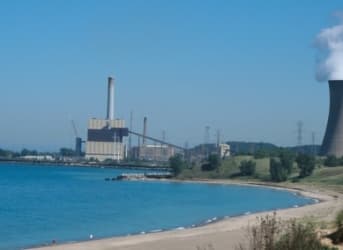Water and energy have a symbiotic relationship. Energy is needed to move water to people and businesses. Water, in turn, is necessary to produce energy.
Of course, different types of energy require varying levels of water use. Take electricity generation as an example. For the United States, electricity generation in 2014 came from the following sources: 38 percent from coal, 27 percent from natural gas, 19.5 percent from nuclear, 6 percent from hydropower, close to 7 percent from non-hydro renewables, and the remainder from a collection of smaller sources.
.png)
But those sources of electricity use water at very different rates. The chart below, using data from a new report from the U.S. Geological Survey, details how water intensive electricity generation is, measured in liters of water needed to generate one kilowatt-hour of electricity. Related: What’s Really Behind The U.S Crude Oil Build
One significant factor that determines the ultimate volume of water a power plant needs is its cooling system. Most conventional power plants use either a “once-through” system or a cooling “tower.” A once-through system pulls water from a river or a lake, cycles the water through the power plant to help generate electricity, and then discharges it back into the environment. In contrast, a tower recirculates the water instead of discharging it. But towers end up using 30 to 70 percent more water because the water ends up being lost through evaporation, whereas the once-through system returns the water to the river or lake.
.png)
However, it should be noted that once-through systems likely have higher levels of consumption than can be measured, because the higher temperature for the discharged water raises the temperature of the river, resulting in higher evaporation downstream that isn’t accounted for. Related: Top 12 Media Myths On Oil Prices
Because returning hotter water back into a river can have harmful effects on plant and wildlife, federal regulations beginning in the 1970’s have ensured that most modern power plants use towers.
Based on the data, nuclear power and natural gas steam generation uses the most water to generate a single kilowatt-hour of electricity. Natural gas uses quite a bit of water in the drilling phase (see: fracking), which makes it more water-intensive than coal. But natural gas combined-cycle (CC) plants are much more efficient.
Nuclear power has some unique water needs that other sources do not. Aside from power generation, nuclear plants must use a lot of water to keep spent fuel rods from overheating. Fuel rods sit in pools of water for years in order to cool down. Still, while coal uses less water on a per-kilowatt-hour basis, it accounts for a higher share of the electricity market, so it uses more overall water than nuclear or natural gas.
Biomass, although not a large source of electricity, is also water-intensive. That is because in addition to generating power, water must go into growing the crops. Hydropower, as its name suggests, is relatively water-intensive as well. Related: How Much Longer Can OPEC Hold Out?
Wind and solar photovoltaics stand alone as sources of electricity that use negligible levels of water to generate electricity.
Water use is rarely the top concern for utilities when they are building new power plants. But that will likely change, at least in areas that are seeing water availability shrink and temperatures rise.
For example, in 2011 Texas suffered through its worst drought on record with 100 days of temperatures in the triple digits. Higher temperatures increased electricity demand by 6 percent and water demand by 9 percent. With reservoirs running low, Texas was forced to build a water pipeline to find a new source of water for the Luminant coal-fired power plant to stay online. Or look at the Browns Ferry Nuclear Power Plant in Alabama, which had to curtail generation several times between 2007 and 2011 because temperatures in the Tennessee River exceeded federal limits.
ADVERTISEMENT
Or look to California, where the ongoing drought has reached a crisis point. San Diego is looking to the Pacific for water. The $1 billion Carlsbad Desalination Project aims to produce 50 million gallons of fresh water per day from the seas, enough to supply water for 300,000 people. That could ease the water problems for the SoCal city. But desalination plants will also require a lot of energy. The Carlsbad Desalination Project will run on natural gas.
By Nick Cunningham Of Oilprice.com
More Top Reads From Oilprice.com:
- Shell Betting Its Future On LNG
- Why Cheap Natural Gas Could Be Here To Stay
- Huge 100 Billion Barrel Oil Discovery Near London

















